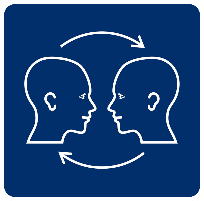
See: Definitions and information at Communication Matters
Note: different types of AAC equipment are listed on the Communication Matters website and the ACE Centre SpeechBubble database
What is a Communication Aid?
A communication aid helps an individual to communicate more effectively with people around them.
Communication aids are also referred to as AAC devices. AAC refers to Augmentative and Alternative Communication, which Communication Matters define as,
… a huge range of techniques which support or replace spoken communication. These include gesture, signing, symbols, word boards, communication boards and books, as well as Voice Output Communication Aids (VOCAs).
There are two main types of AAC system: Unaided Communication and Aided Communication.
Unaided communication does not use additional equipment. People typically use body language, gesture, vocalisation or signing.
Aided communication uses equipment – this can range from low-tech to hi-tech methods and often uses pictures and symbols instead of, or together with words. Alternative hardware options are available to provide access. A low-tech method of communication such as a simple, laminated communication book to carry around with a few pages of pictures or symbols is a communication aid. However, the term “device” only describes a more hi-tech solution. An electronic communication aid can be a dedicated device designed only to help the user communicate. Alternatively, the device could be a standard computer on which the user has installed specialist communication aid software. Note that touchscreen tablets such as iPads are increasingly being used to help people communicate.
AAC equipment – both hardware and software – may also be referred to as “AAC systems”. Each has pros and cons and what is suitable for one person will not necessarily suit a different user. Low-tech solutions are not inferior to hi-tech solutions. What you choose will depend on personal preference, abilities and needs. The method of access, environmental factors and funding are also deciding factors. A specialist assessment through a speech and language therapist or communication aid centre will help to identify a person’s most appropriate AAC system or systems.
The hardware and software are not the full picture, however. Training and ongoing support are vital factors in determining someone’s successful use of a communication aid.
Useful Links:
Disclaimer: while we believe these information sources to be accurate, we strongly advise you to make your own independent enquiries.
See also
- Factsheet – Causes of Dysarthria
- Factsheet – Dysarthria and Dysphasia
- Factsheet – Funding for communication aids
- Factsheet – Role of the Occupational Therapist
- Factsheet – Role of the Speech & Language Therapist
- Factsheet – The right communication aid?
- Factsheet – What is a communication aid?
- Factsheet – What is a stroke?
- Factsheet – What is Aphasia?






